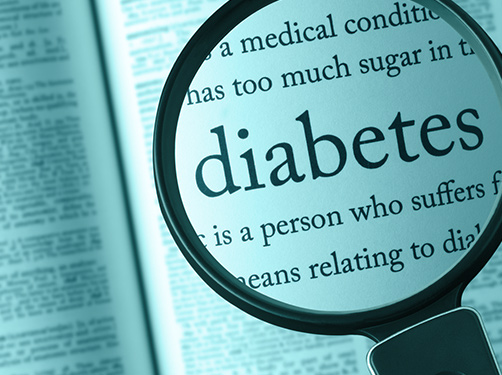Diabetes in old age
Scientific support: Prof. Dr. Michael Hummel
Around 3 million people in Germany over the age of 65 have diabetes. In those over the age of 80, one in three is affected. In principle, older people with type 1 or type 2 diabetes don’t require different treatment to young people. However, it can be beneficial to adapt the therapy to the different needs and potential limitations of older people.
Well-managed blood sugar levels remain important in old age to prevent the complications associated with permanently elevated blood sugar levels. However, quality of life increasingly moves into the foreground of the treatment. Is the patient coping well with the therapy? Or are there physical or mental problems making the treatment difficult? In consultation with the patient, the doctor must always tailor the therapy to the individual possibilities and circumstances.

Dangerous low blood sugar level in old age
For older people, low blood sugar levels can be especially dangerous. Firstly, it increases the risk of having a fall. Furthermore, there is evidence that regular episodes of low blood sugar (hypoglycemia) can promote the onset of dementia and negatively affect memory and motor skills. It also increases susceptibility to cardiovascular diseases, such as heart attacks.
For this reason, one of the main focuses of diabetes treatment in old age is the prevention of low blood sugar levels. These episodes become more frequent in old age. This is because the long-term nature of the diabetes reduces the perception threshold for low blood sugar levels sugar and the blood sugar-increasing countermeasures of the body are initiated later.
Good to know:
The avoidance of low blood sugar levels is especially important for older people.
In older patients, the long-term blood sugar (HbA1c) and fasting blood sugar levels should be higher than the levels for younger people to prevent the onset of low blood sugar levels. The target value always depends on the individual situation and condition of each patient.
- For older people without any significant limitations, a comparatively strict HbA1c value of between 7.0 to 7.5 percent (53.0 to 58.5 mmol/mol) can be beneficial, as well as a fasting blood sugar level of between 100 and 125 mg/dl (5.6 to 6.9 mmol/l).
- For older people requiring care or those suffering several diseases, a HbA1c value above 8.0 percent (63.9 mmol/mol) and a fasting blood sugar level of up to 150 or 180 mg/dl (8.3 to 10 mmol/l) can be advisable to prevent low blood sugar levels.
To prevent low blood sugar levels in patients with type 2 diabetes, in certain situations, the specialist medical personnel may have to adjust the blood sugar-reducing medication. Medications and combinations with the lowest possible risk of low blood sugar are preferable. For this reason, blood sugar-reducing medications from the sulfonylurea class of medications are considered to be less suitable. In older patients, a combination therapy using various blood sugar-reducing substances is more likely to cause side effects.
The first-choice medication for the treatment of type 2 diabetes in older patients is metformin. In cases of reduced kidney function (a glomerular filtration rate of less than 30 milliliters per minute) or situations in which impaired renal function can be assumed, therapy with metformin should be discontinued. For example, when a patient has a febrile infection or when an operation under general anesthetic is planned. Before surgical interventions and for hospital stays in general, people with diabetes should always provide the hospital staff with details of the medication they are currently taking.
Insulin therapy to treat type 2 diabetes can be necessary if tablets are no longer sufficient to manage blood sugar levels. The choice of the right injection plan is based on the wishes of the patient and the individual possibilities and abilities of each patient.
Find out more about insulin therapy here!
Intensified insulin therapy enables almost complete flexibility in planning everyday life and diet. However, it does place more responsibility on the patient. Each patient is responsible for independently estimating the amount of carbohydrates contained in each meal and then subsequently injecting the required amount of insulin, consisting of a combination of short-acting and long-acting insulins. On the other hand, conventional insulin therapy is easier to manage but offers less freedom. Even for people with type 1 or type 2 diabetes who have used intensified insulin therapy for many years, it may be beneficial for them to switch to a simpler regimen as their mental capacity declines in older age.
People with type 2 diabetes who switch to insulin in old age should learn how to correctly use the insulin pen by participating in training classes. The certified course “Staying fit and aging with diabetes” from the German Diabetes Association specifically targets older people with type 2 diabetes who inject insulin. Ask your diabetes counselor for more information.
Patients can also seek advice when selecting the tools best suited to them. There are insulin pens that are very easy to use and only require light pressure to inject the insulin.
Along with good blood sugar management, good control of blood pressure and blood lipid levels is important to help prevent complications. High blood pressure is a common complication in older patients. According to the Robert Koch Institute, around two-thirds of people over 65 in Germany have high blood pressure. Because both high blood pressure and high sugar levels increase the risk of developing cardiovascular diseases, the reduction of blood pressure is an important preventive measure for older patients. The optimal levels depend on each patient’s circumstances.
The same applies to blood lipid levels. In particular, the increased presence of LDL cholesterol in the blood vessels increases the risk of cardiovascular damage. Good management of this aspect, using statins if necessary, is an important therapeutic goal for older patients with diabetes. If no other risk factors are present, an LDL cholesterol level of below 100 mg/dl (2.5 mmol/l) is advisable. If there are other preexisting diseases that increase the cardiovascular risk, such as diabetic kidney damage, then the LDL cholesterol level should be reduced to below 70 mg/dl (1.8 mmol/l) or at least halved.
A tablet to combat high blood pressure, one for the thyroid, and another to reduce blood sugar levels: Older patients may suffer from several diseases at the same time with each requiring a different type of medication. This can quickly lead to a patient taking 6 or more medications at the once. This phenomenon is known as “multimedication”. Specialists are taking an increasingly critical stance. Using several different types of drugs increases the probability of unwanted side effects, such as dizziness, nausea, or drowsiness. Additionally, patients tend not to adhere to the therapy ordered by medical specialists due to the side effects. In the case of diabetes, this is compounded by the risk of low blood sugar levels.
- When unwanted adverse effects stemming from a mix of medications are suspected, the patient should not stop using the medication by themselves, but rather talk to their doctor about their suspicions. There are often more tolerable alternatives or a medication has become unnecessary in the meantime.
- To avoid issue related with multimedication, it is advisable to designate a a trusted physician to maintain an overview of the prescribed medication.
- Furthermore, the specialist medical staff should regularly assess whether the use of all the medications is necessary.
- It is also helpful for patients to compile a medication plan with the help of a physician. This plan should list all the medications to be taken. If needed, this overview can be provided to another physician if they plan to prescribe a new medication or given to hospital staff in the event of an inpatient stay.
Good diabetes management is often difficult for people requiring nursing care. The focus is usually placed on preventing episodes of low blood sugar levels and the long-term complications of diabetes, such as diabetic foot syndrome.
If care staff or family caregivers become responsible for parts of the therapy, they must receive the appropriate training. The German Diabetes Association (Link in German) offers the further qualification in diabetes care “DDG specialist nurse for long-term care” and the “basic qualification in diabetes care”. If a person is to be moved to a retirement home, the relatives should inquire whether there are suitably qualified staff.
It is also important for the the treating physician and those providing care to remain in close contact with one another. This enable both sides to better assess potential risks associated with the current treatment measures for the patient and, if needed, adjust the course of therapy.
There are many aids that can make everyday life easier for older people with diabetes. For example:
- A blood sugar measurement device with a large screen or voice function
- Measurement devices that automatically digitally store the readings
- Easy-to-use insulin pens
- Non-slip socks to prevent falls Hip-protector pants to protect against injury
- A clock or mobile phone application to remind them when to take medication or insulin
- Pill organizer
Sources:
Deutsche Diabetes Gesellschaft: S2k-Leitlinie Diagnostik, Therapie und Verlaufskontrolle des Diabetes mellitus im Alter. Langfassung. 2. Auflage. 2018
Neuhauser, H. et al.: 12-Monats-Prävalenz von Bluthochdruck in Deutschland. In: Journal of Health Monitoring, 2017, 2: 57-63
Zeyfang, A. et al.: Diabetes mellitus im Alter. In: Diabetologie, 2018, 13: S185-S191
As of: 08.11.2019



